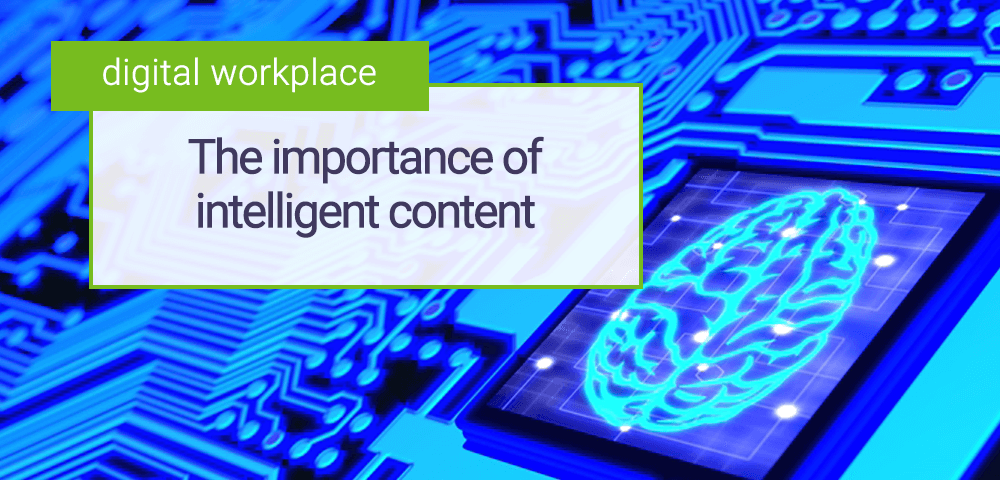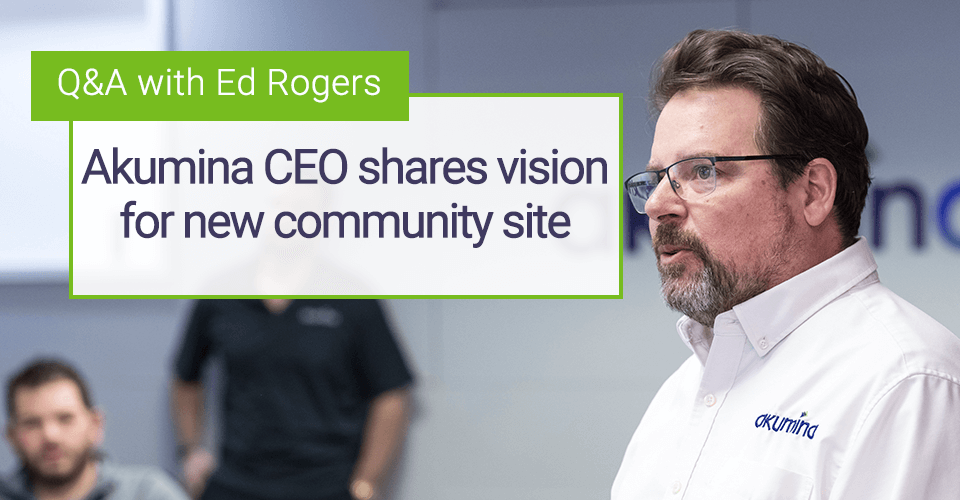Importance of intelligent content in the digital workplace

“Artificial intelligence” is a buzzphrase whose buzz is only getting louder. At Akumina, what we’re hearing is the desire of organizations to connect AI with employee-facing content to create a better, stickier, and more engaging employee experience. In other words, the desire to create “intelligent content.”
But what does intelligent content mean? How do you make it happen? Perhaps more importantly, why should you care? Let’s take a look at Intelligent Content through those three lenses.
What is intelligent content?
As it applies to employee experience, I would define Intelligent Content as a convergence of technology, planning, and structure to deliver needed or necessary information to employees precisely when they need it. The concept is very similar to Just-in-Time manufacturing.
This content can take numerous forms:
- web pages
- documents
- articles
- forms
- video
- images
- applications and productivity software
This content also will often mirror or duplicate the various digital content and experiences that employees engage with outside of the workplace. This fact matters because like the public-facing social and website digital journey, the digital workplace and employee experience are following a very specific path toward targeted, personalized, and adaptive experiences based upon individual employees, timing, business needs, and other inputs.
And here’s the “intelligent” part.
Just like marketing content, content developed for internal consumption will be delivered more and more dynamically, eventually even without any human intervention at all. Content in all its forms today can be delivered to consumers predictively and precisely in response to digital behaviors and characteristics.
In the digital workplace, this content and experience, delivered to those who need it, cut across department, region, and other business silos to create highly informed and prepared, knowledge-based workers, regardless of industry. In this way, we can say that it’s not just the content that’s intelligent, but also the business, process, and—perhaps most importantly— the employee.
What is needed to create and deploy Intelligent Content?
Intelligent Content sounds pretty awesome. But how do you make it happen?
The good news is that we are not blazing a trail through virgin territory: the path to Intelligent Content for the digital workplace has been cleared by public-facing sites and digital marketing. Creating Intelligent Content boils down to the following “core 4” elements: categorization, information, analytics, and intelligence.
Core element #1: Categorization
Categorization of content requires planning and forethought. Start with an assessment of your content that covers:
- the various types of content or content areas
- the and usage of the content
- file type
- delivery channel
- intended audience/use
Core element #2: Information
Next, we need user information, which can cover a wide range:
- department
- location
- title
- workgroup
Additionally, manager and direct report designations can be gathered to construct another piece of visual content, an org chart.
It’s worth noting here (from our experience at Akumina) that no one’s employee data is as clean as they want or expect it to be. A significant amount of effort in constructing a modern digital workplace will be spent surfacing, cleaning up, and normalizing employee data.
Core element #3: Analytics
The third is a staple of marketing website analytics: a set of content and behavioral analytics. To make good decisions about what is working (and fuel machine intelligence) good data must be gathered. Table stakes here are the typical web analytics of clicks and pathing—the basics.
Then adding predictive analytics, we can not only see what others have done or looked for, but also deliver highly educated guesses around what an employee is trying to accomplish. Perhaps more importantly, predictive analytics can “read” what the business needs each individual to accomplish, thereby driving enhanced employee productivity and higher business value.
Core element #4: Machine Intelligence
Simple machine intelligence and automation can and should be used to deliver a baseline of content, data, and workloads dynamically so that my employee content experience is not quite the same as yours. Simple integrations of schedule, tasks, and communication are the entry point. Then, an individual’s known history of interactions can inform the drawing of predictive paths to content and information that are relevant and impactful to the employee. Once a confirmation is produced that the prediction is correct, the most appropriate workload or workflow can be initiated to expedite completion of the task.
What does Intelligent Content enable?
Even with a plan to assemble the pieces and wire up the needed tech, the question remains: so what? What are the business benefits? I’ll answer those questions by discussing three powerful capabilities of Intelligent Content: search, bots, and predictive content.
Powerful search
Thanks to Google and the high expectations it has created, even advanced search has become straightforward. When we look at providing an enhanced search experience in the digital workplace, we need to have the structure and planning that properly executed Intelligent Content can provide. Even simple enhancements such as type-ahead and relevancy require significant forethought, but to add predictive elements and create actionable recommendations requires intelligence.
Additionally, remember that our definition of content, in this case, can include workloads and applications—all categorized and analyzed to allow for delivery into the search results as recommendations. Here we’re bringing intelligence to content, creating a first-level rudimentary next best action delivery (more below).
Powerful bots
With a well-defined content structure and an understanding of the relevant behaviors around that content, we have a strong opportunity to deliver on the promise of bot technology. Whether enhancing a search experience with a recommendation bot (as mentioned above) or providing a bot assistant that can help guide employees in an almost human fashion, the overall experience and stickiness are enhanced. See how it’s happening now in retail.
Powerful predictive content
Now imagine employees receiving needed, relevant content to their portals without requesting it. Now we are in the world of predictive content that is delivered based upon any of several criteria including location, job function, and peers, but also and perhaps more importantly based upon behavior, time of year, or tasks in a queue. This capability, which I refer to as “Just-in-Time Content,” becomes the formative base of what is perhaps the most impactful advance available to a fully mature digital workplace, next best action.
Next best action: The next big thing in the digital workplace?
A maturing technology on public-facing sites, next best action has seen little use in internal communication. But its time is coming.
Imagine a portal where your tasks, meetings, and interactions are all available to an analytics engine right beside your peers. From this data, efficiencies in work and process can be derived. Information and work processes can be delivered to knowledge and information workers to take the most impactful and timely decisions.
This is a mature technology in manufacturing and assembly. Applying it to the workloads of knowledge workers can allow the most capable subject matter experts to lend just the right information at exactly the right time in a decision or data review process. These actions, like predictive content, would be exposed in the context of the daily experience and tasks, but could also be connected to collaborative work, allowing employees to seamlessly weave in and out of work-based conversations and collaborations.
Where do you start?
The good news is that if you are a Microsoft O365 and Akumina customer, then many of the underpinnings needed to accomplish these (and other) benefits of Intelligent Content are already available to you—they simply need to be configured and customized.
In addition, many of our customers use other search, machine intelligence, and analytics technologies other than those provided in the Microsoft set of products—that’s fine too. The Akumina framework can be integrated to deliver on the promise of Intelligent Content with many of these systems, centralizing data to deliver the right message to the right person at the right time.



